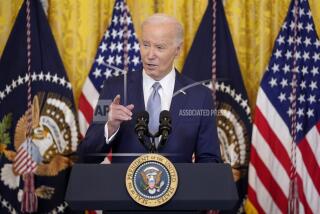Federal judge halts preparations for end of U.S. asylum limit

NEW ORLEANS â A federal judge on Wednesday ordered a two-week halt in the phasing out of pandemic-related restrictions on seeking asylum and raised doubts about the Biden administrationâs plan to fully lift those restrictions on May 23.
For now, the decision is a temporary setback for the administration, but the judge staked out a position that is highly sympathetic with Louisiana, Arizona and 19 other states that sued to preserve so-called Title 42 authority, which, on grounds of preventing the spread of COVID-19, denies migrants a chance at asylum.
The states âhave established a substantial threat of immediate and irreparable injury resulting from the early implementation of Title 42, including unrecoverable costs on healthcare, law enforcement, detention, education, and other services for migrants,â U.S. District Judge Robert Summerhays wrote in Lafayette, La.
Summerhays, who was appointed by former President Trump, said states were likely to succeed with their argument that the administration failed to adhere to federal procedures when it announced April 1 that it was ending Title 42 authority.
The Biden administration has released a plan to deal with an increase in already historic numbers of migrants at the U.S.-Mexico border.
The judge has scheduled a hearing on May 13 in Lafayette for arguments on whether to block Title 42 from ending as planned 10 days later.
Texas filed a similar lawsuit filed Friday in federal court in Victoria, Texas.
The decision to end Title 42 authority was made by the federal Centers for Disease Control and Prevention. It has come under growing criticism from elected officials in Bidenâs Democratic Party who contend that the administration is unprepared for an anticipated increase in asylum seekers.
The Justice Department declined to comment on the order, but the administration has said it will comply, while warning it will hamper preparations for Title 42 to end on May 23.
About 14% of single adults from Guatemala, Honduras and El Salvador were processed under immigration laws, not Title 42, during a seven-day period ending Thursday. Thatâs up from 5% in March, according to government figures.
Summerhaysâ order requires the Homeland Security Department to âreturn to policies and practices in placeâ before it announced plans to end Title 42 and to submit weekly reports that demonstrate it is acting âin good faith.â
Migrants have been expelled more than 1.8 million times under the rule invoked in March 2020 by the Trump administration. Migrants were stopped more than 221,000 times at the U.S.-Mexico border in March, a 22-year high that has raised concerns about the governmentâs ability to handle even larger numbers when Title 42 is lifted.
Advocates for asylum seekers say the restrictions endanger people fleeing persecution back home and violates rights to seek protection under U.S. law and international treaty. As the CDC acknowledged, the public health justification for the order has weakened as the threat of COVID-19 has waned.
At two often contentious hearings Wednesday, Department of Homeland Security Secretary Alejandro N. Mayorkas sought to defend the administrationâs handling of an increase in migrants at the southwestern border and its plans to deal with the prospect of more with the potential end of Title 42.
Mayorkas defended his position against Republican accusations that the administration has encouraged irregular migration by allowing some people to seek asylum; instead, he blamed economic and political turmoil and violence throughout Latin America and the world.
âSome of the causes of irregular migration have only been heightened by years of distress preceding this administration,â he said.
Mayorkas testified one day after Homeland Security released a plan with more details about how it was preparing for the end of Title 42 authority.
Associated Press reporter Ben Fox in Washington contributed to this report.
More to Read
Sign up for Essential California
The most important California stories and recommendations in your inbox every morning.
You may occasionally receive promotional content from the Los Angeles Times.






![[20060326 (LA/A20) -- STATING THE CASE: Marchers organized by unions, religious organizations and immigrants rights groups carry signs and chant in downtown L.A. "People are really upset that all the work they do, everything that they give to this nation, is ignored," said Angelica Salas of the Coalition of Humane Immigrant Rights. -- PHOTOGRAPHER: Photographs by Gina Ferazzi The Los Angeles Times] *** [Ferazzi, Gina -- - 109170.ME.0325.rights.12.GMF- Gina Ferazzi/Los Angeles Times - Thousands of protesters march to city hall in downtown Los Angeles Saturday, March 25, 2006. They are protesting against House-passed HR 4437, an anti-immigration bill that opponents say will criminalize millions of immigrant families and anyone who comes into contact with them.]](https://ca-times.brightspotcdn.com/dims4/default/34f403d/2147483647/strip/true/crop/1983x1322+109+0/resize/840x560!/quality/75/?url=https%3A%2F%2Fcalifornia-times-brightspot.s3.amazonaws.com%2Fzbk%2Fdamlat_images%2FLA%2FLA_PHOTO_ARCHIVE%2FSDOCS%2854%29%2Fkx3lslnc.JPG)




